North and South Brother Islands (New York City)
North and South Brother Islands are a pair of small islands located in New York City's East River between the mainland Bronx and Rikers Island. North Brother Island was once the site of a hospital, but is now uninhabited and designated as a bird sanctuary.[1] It had long been privately owned, but it was purchased by the city in 2007.
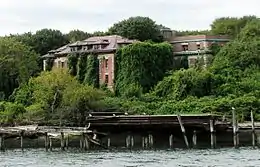 The remains of Riverside Hospital on North Brother Island, 2006 | |
 North and South Brother Islands  North and South Brother Islands  North and South Brother Islands | |
| Geography | |
|---|---|
| Location | East River, New York City |
| Coordinates | 40°47′54″N 73°53′54″W |
| Total islands | 2 |
| Administration | |
| State | New York |
| City | New York |
| Borough | The Bronx |
According to the New York City Parks Department, which oversees the islands, North Brother Island has about 20 acres (8 hectares) of land,[2] and South Brother Island about 6 acres (2.4 ha).[3]
History
.jpg.webp)
Both North Brother Island and South Brother Island were claimed by the Dutch West India Company in 1614 and were originally named "De Gesellen", translated as "the companions" in English.[4]
The islands were both originally part of Queens County. On June 8, 1881, North Brother Island was transferred to what was then part of New York County (later to become the Bronx).[5] On April 16, 1964, South Brother Island was also transferred to the Bronx.[6] The islands had been incorporated into Long Island City in 1870,[7] before the consolidation of New York City in 1898.[8]
North Brother Island
The northern of the islands was uninhabited until 1885, when Riverside Hospital moved there from Blackwell's Island (now known as Roosevelt Island). Riverside Hospital was founded in the 1850s as the Smallpox Hospital to treat and isolate victims of that disease. Its mission eventually expanded to other quarantinable diseases. The last such facility to be established on the island was the Tuberculosis Pavilion, which opened in 1943, and was rendered obsolete within the decade due to the increasing availability, acceptance, and use of the tuberculosis vaccine after 1945.[9]
The island was the site of the wreck of the General Slocum, a steamship that burned on June 15, 1904: 1,021 people died either from the fire on board the ship, or from drowning before the ship beached on the island's shores.[10]
According to Joseph Mitchell, a reporter for newspapers and for The New Yorker, the island was the site of many outings of "The Honorable John McSorley Pickle, Beefsteak, Baseball Nine, and Chowder Club" organized by John McSorley of McSorley's Old Ale House; photos of the outings are featured on the walls of the bar.[11]
Mary Mallon, also known as Typhoid Mary, was confined to the island for over two decades until she died there in 1938.[12][4] The hospital closed shortly thereafter.
Following World War II, the island housed war veterans who were students at local colleges and their families. After the nationwide housing shortage abated, the island was again abandoned until the 1950s, when a center opened to treat adolescent drug addicts. The facility claimed it was the first to offer treatment, rehabilitation, and education facilities to young drug offenders. Heroin addicts were confined to this facility and locked in a room until they were clean. Many of them believed they were being held against their will. Staff corruption and cost forced the facility to close in 1963.[9] The facility is said to have been the inspiration for the Broadway play Does a Tiger Wear a Necktie?, which helped to launch the career of Al Pacino.[9]
Since the mid-1960s, New York City mayors have considered a variety of uses for the island. John Lindsay, for instance, proposed to sell it, and Ed Koch thought it could be converted into housing for the homeless. The city also considered using it as an extension of the jail at Rikers Island.[9]
Now serving as a sanctuary for herons and other wading shorebirds,[9][1] the island is presently abandoned and off-limits to the public. Most of the original hospitals' buildings still stand, but are heavily deteriorated and in danger of collapse, and a dense forest conceals the ruined hospital buildings. In October 2014, New York City Council member Mark Levine, Chair of the City Council's Parks Committee, led a delegation to visit the island,[13] and declared his desire afterward to open the island for limited "light-touch, environmentally sensitive" public access.[14] In October 2016, New York magazine reported that the council had commissioned a study from the University of Pennsylvania's School of Design, followed by a public hearing, on how the island could be converted into a park with controlled access by the public.[9]
- North Brother Island
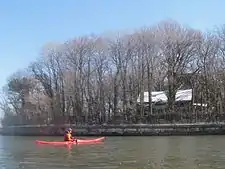 Kayaker at North Brother Island, with the Caretaker's House in disrepair in the background.
Kayaker at North Brother Island, with the Caretaker's House in disrepair in the background.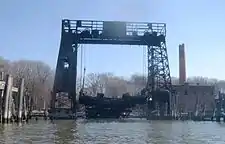 Ruins of the ferry dock at North Brother Island.
Ruins of the ferry dock at North Brother Island.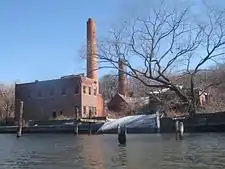 Old Plant at North Brother Island.
Old Plant at North Brother Island.
South Brother Island
In the mid-19th century, Alfred W. White, who was in charge of public health for the city, used South Brother Island as the city's first dump, where garbage, manure, offal and carcasses were sent to help clean up the city, which consisted at that time of only Manhattan and its islands. However, the island is only about a half-mile from the Bronx and the country estates of the city's rich, such as William Ligett and Jacob Lorillard, both scions of tobacco families. It was also close enough to the shoreline villages of Queens County to be noxious to them as well, and the combination of Queens villages and wealthy Bronxites convinced the Queens County Supreme Court to stop the dumping.[15]
Jacob Ruppert, a brewery magnate and early owner of the New York Yankees, had a summer house on the island that burned down in 1909.[4] No one has lived on the island since then, and there are no structures extant. Ruppert owned the island until the late 1930s, and in 1944 it was purchased by John Gerosa, president of the Metropolitan Roofing Supply Company, who had wanted to construct a never-built summer retreat for his workers on the island.
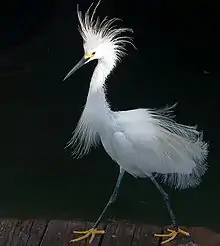
In 1975, the City sold South Brother Island to Hampton Scows Inc., a Long Island investment company, for $10.[4][16] Hampton Scows paid property taxes every year but did not develop the island.
In November 2007, the island was purchased in a complicated transaction in which $2 million of Federal grant money from the National Oceanic and Atmospheric Administration's Coastal and Estuarine Land Conservation Program was allocated to the Wildlife Conservation Society and The POINT Community Development Corporation. The Trust for Public Land then acquired the island on behalf of those organizations, and then donated it to the city's Parks Department as a wildlife sanctuary.[3][4] It is managed by the city's Parks Department and the Bronx Zoo.[16][17] South Brother Island was the 13th island to come under the Parks Department's jurisdiction.[3]
Wildlife
North Brother Island is a designated wildlife sanctuary.[9][1] From the 1980s through the early 2000s, North Brother Island supported one of the area's largest nesting colonies of black-crowned night heron. However, as of 2008 this species has abandoned the island for unknown reasons.[18] Barn swallows use the abandoned structures for nesting, and can be seen flying over the island.
On South Brother Island, dense brush supports a major nesting colony of several species of birds, notably black-crowned night heron, great egret, snowy egret, and double-crested cormorant. New York City Audubon has monitored nesting colonies on the island for over twenty years.[19][20]
In popular culture
In June 2009, North Brother Island was featured in episode 8 ("Armed and Defenseless") of Life After People on the History Channel. It was used as an example of what would happen to structures after 45 years without humans.[21] It was featured in the Broad City episode "Working Girls" and was mentioned in the episode "Twaining Day", It was also featured in the Unforgettable episode "The Island". It is also a location inhabited by women and children in Victor LaValle's 2017 novel, The Changeling.
See also
References
- Kevin Walsh (May 10, 2019). "The Burning Decks". Splice Today. Retrieved May 10, 2019.
- Staff (November 21, 2001) "Daily Plant: Over 2001 Acres Gained by October 2001" New York City Department of Parks and Recreation
- Staff (November 29, 2007) "The Daily Plant: South Brother Island Goes To The Birds" New York City Department of Parks and Recreation
- Williams, Timothy (November 20, 2007). "City Claims Final Private Island in East River". The New York Times. Retrieved May 26, 2008.
- New York (State) (1881). Laws of the State of New York: Passed at the Session of the Legislature. Session laws of American states and territories prior to 1900. New York State Legislature. p. 649. Retrieved April 11, 2020.
- New York (State) (1964). Laws of the State of New York. publisher not identified. p. 1606. Retrieved April 11, 2020.
- Beers, F.W. (1873). Long Island City. Long Island (Map). Beers, Comstock & Cline. Retrieved October 1, 2016.
- The Greater New York Charter as Enacted in 1897: With Notes Indicating the Derivatory Statutes and References to Judicial Decisions Relating Thereto, Together with Appendixes ... and the English Colonial Charters. Weed-Parsons. 1897. p. 818. Retrieved April 11, 2020.
- Kirby, Jen (October 27, 2016). "NYC's North Brother Island, Abandoned for 50 Years, Might Finally Be Opened to (Legal) Visitors". Intelligencer. Retrieved December 29, 2019.
- Staff (June 16, 1904). "The General Slocum An Unlucky Craft. Has Had Collisions And Accidents By The Score. Has Run Ashore Many Times. She Was a Crack Harbor Boat Thirteen Years Ago. Capt. Van Schaick's Good Record". The New York Times. Retrieved February 28, 2010.
- Mitchell, Joseph (2015) Up in the Old Hotel and other stories (Kindle Edition) New York: Vintage. p.6. ISBN 0679746315
- "'Typhoid Mary' Dies of A Stroke at 68. Carrier of Disease, Blamed for 51 Cases and 3 Deaths, but She Was Held Immune". The New York Times. November 12, 1938. Retrieved February 28, 2010.
- Foderaro, Lisa (October 15, 2014). "On an Island Under Vines, New York City Officials See a Future Park". The New York Times. Retrieved November 2, 2014.
- Chung, Jen (October 16, 2014). "A Rare, Legal Visit To 'Spellbinding' North Brother Island". Gothamist. Archived from the original on October 27, 2014. Retrieved November 2, 2014.
- Eldredge, Niles and Horenstein, Sidney (2014). Concrete Jungle: New York City and Our Last Best Hope for a Sustainable Future. Berkeley, California: University of California Press. pp. 147–48. ISBN 978-0-520-27015-2.
- Freedlander, David (November 20, 2007). "New York's South Brother Island to be a sanctuary". New York Newsday. Retrieved May 26, 2008.
- Block, Dorian (November 27, 2007). "City buys South Brother Island on East River for bird refuge". Daily News. New York.
- Craig, Elizabeth (December 22, 2009). "Audubon's Harbor Herons Project: 2009 Interim Nesting Survey Report" (PDF). New York City Audubon.
- Craig, Elizabeth (November 12, 2012). "2012 Interim Nesting Report" (PDF). NYC Audubon. Retrieved June 25, 2013.
- Berger, Joseph (December 4, 2003). "So, You Were Expecting a Pigeon?; In City Bustle, Herons, Egrets and Ibises Find a Sanctuary". The New York Times. Retrieved August 21, 2007.
- "Armed and Defenseless". History Channel. Archived from the original on October 28, 2009. Retrieved February 28, 2010.
Further reading
- Mosher, Dave (October 8, 2017) "New York City owns a creepy island that almost no one is allowed to visit — here's what it's like" UK Business Insider
- Seitz, Sharon & Miller, Stuart (2003) The Other Islands of New York. Woodstock, Vermont: Countryman Press. ISBN 0-88150-502-1.
- Staff (August 14, 1954) "Talk of the Town", The New Yorker, p. 15.
- Staff (January 3, 2013) "The Forgotten Island of New York: North Brother." Sometimes Interesting
- United States Census Bureau (2000) North Brother and South Brother Islands: Block 9000, Block Group 9, Census Tract 5, Bronx County, New York
External links
| Wikimedia Commons has media related to North and South Brother Islands. |
- NYC property tax records See Valuation/Assessment for Bronx Block 2605 Lot 35.
- NYC Audubon Western Long Island Sound Project – includes Harbor Herons
- "North Brother Island may someday open to the public" Curbed New York (additional images)
- Abandoned Riverside Hospital history and photos
- Comprehensive history and photo essay on the state of North Brother Island from 2008-2011
